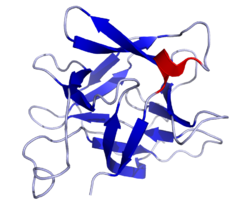Processing
Cytokines usually contain the signal peptide which is necessary for their extracellular release. However, the IL-18 protein, similar to other IL-1 family members, lacks this signal peptide. [11] Furthermore, similar to IL-1β, IL-18 is produced as a biologically inactive precursor. IL-18 gene encodes for a 193 amino acids precursor, first synthesized as an inactive 24 kDa precursor with no signal peptide, which accumulates in the cell cytoplasm. Similarly to IL-1β, the IL-18 precursor is processed intracellularly by caspase 1 in the NLRP3 inflammasome into its mature biologically active molecule of 18 kDa. [12]
Receptor and signaling
IL-18 receptor consists of the inducible component IL-18Rα, which binds the mature IL-18 with low affinity and the constitutively expressed co-receptor IL-18Rβ. IL-18 binds the ligand receptor IL-18Rα, inducing the recruitment of IL-18Rβ to form a high affinity complex, which signals through the toll/interleukin-1 receptor (TIR) domain. This signaling domain recruits the MyD88 adaptor protein that activates proinflammatory programs and NF-κB pathway. The activity of IL-18 can be suppressed by extracellular interleukin 18 binding protein (IL-18BP) that binds soluble IL-18 with a higher affinity than IL-18Rα thus preventing IL-18 binding to IL-18 receptor. [13] [14] IL-37 is another endogenous factor that suppresses the action of IL-18. IL-37 has high homology with IL-18 and can bind to IL-18Rα, which then forms a complex with IL-18BP, thereby reducing the activity of IL-18. [15] Moreover, IL-37 binds to single immunoglobulin IL-1 receptor related protein (SIGIRR), also known as IL-1R8 or TIR8, which forms a complex with IL-18Rα and induces an anti-inflammatory response. The IL-37/IL-18Rα/IL-1R8 complex activates the STAT3 signaling pathway, decreases NF-κB and AP-1 activation and reduces IFNγ production. Thus, IL-37 and IL-18 have opposing roles and IL-37 can modulate pro-inflammatory effects of IL-18. [16] [15]
Clinical significance
Apart from its physiological role, IL-18 is also able to induce severe inflammatory reactions, which suggests its role in certain inflammatory disorders such as chronic inflammation and autoimmune disorders. [19] High levels of IL18 have also been described in essential hypertensive subjects [20]
Endometrial IL-18 receptor mRNA and the ratio of IL-18 binding protein to interleukin 18 is significantly increased in adenomyosis patients in comparison to normal people, indicating a role in its pathogenesis. [21]
IL-18 has been implicated as an inflammatory mediator of Hashimoto's thyroiditis, the most common cause of autoimmune hypothyroidism. IL-18 is upregulated by interferon-gamma. [22]
IL-18 has also been found to increase the Alzheimer's disease-associated amyloid-beta production in human neuron cells. [23]
IL-18 is also associated with urine protein excretion which means that it can be marker for assessing the progression of diabetic nephropathy. [24] [25] This interleukin was also significantly elevated in patients with microalbuminuria and macroalbuminuria when it was compared with healthy people and patients with diabetes which have normoalbuminuria. [26]
IL-18 is involved in the neuroinflammatory response after intracerebral hemorrhage. [27]
The single-nucleotide polymorphism (SNP) IL18 rs360719, a genetic variant of the Interleukin-18 (IL-18) gene, revealed a probable role in determining the susceptibility to systemic lupus erythematosus and to be a possible "key factor in the expression of the IL18 gene." [19]
This page is based on this
Wikipedia article Text is available under the
CC BY-SA 4.0 license; additional terms may apply.
Images, videos and audio are available under their respective licenses.






